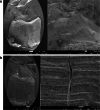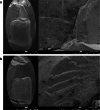The influence of aging on the fracture load of milled monolithic crowns
- PMID: 36402987
- PMCID: PMC9675227
- DOI: 10.1186/s12903-022-02529-z
The influence of aging on the fracture load of milled monolithic crowns
Abstract
Background: This in-vitro study was conducted to assess the effect of aging on the fracture load of molar crowns fabricated with monolithic CAD/CAM materials.
Methods: The crown restorations were produced from Cerasmart, Vita Enamic, and IPS e.max CAD blocks. Aging was applied to the 10 samples each of monolithic CAD/CAM materials (n = 10). Dual-axis chewing simulator (50 N, 1.1 Hz, lateral movement: 1 mm, mouth opening: 2 mm, 1,200,000 cycles) and thermocycling (± 5-55 °C, 6000 cycles) were applied as an aging procedure. 10 samples each of monolithic CAD/CAM materials without aging (n = 10) were considered the control group. 6 tested groups were obtained. Then, all samples were evaluated in a universal testing machine to determine the fracture loading values'.
Results: There was not a statistically significant difference between the fracture load values before and after aging for all samples of Cerasmart, Vita Enamic, and IPS e.max CAD (p > 0.005). In a comparison of the monolithic materials together, a statistically significant difference was found between the fracture load values of IPS e.max CAD and Vita Enamic crowns before aging (p = 0.02). Also, Vita Enamic crowns (1978,71 ± 364,05 N) were found different from the IPS e.max CAD (p = 0.005) and Cerasmart crowns (p = 0.041) after aging.
Conclusions: Dynamic aging with 1.200.000 cycles was found to have no effect to fracture loading on milled Cerasmart, Vita Enamic, and IPS e.max CAD monolithic crowns.
Keywords: Aging; CAD/CAM; Chewing simulator; Fracture load; Monolithic crowns.
© 2022. The Author(s).
Conflict of interest statement
The authors declare that “they have no competing interests”.
Figures



Similar articles
-
Marginal discrepancy and fracture load of thermomechanically fatigued crowns fabricated with different CAD-CAM techniques.J Prosthodont. 2023 Aug;32(7):602-607. doi: 10.1111/jopr.13612. Epub 2022 Oct 31. J Prosthodont. 2023. PMID: 36254611
-
Failure Load of Monolithic Lithium Disilicate Implant-Supported Single Crowns Bonded to Ti-base Abutments versus to Customized Ceramic Abutments after Fatigue.J Prosthodont. 2022 Feb;31(2):136-146. doi: 10.1111/jopr.13369. Epub 2021 May 4. J Prosthodont. 2022. PMID: 33870577
-
[Comparison of fracture strength of two chairside CAD/CAM ceramic blocs with different thickness].Shanghai Kou Qiang Yi Xue. 2021 Feb;30(1):7-12. Shanghai Kou Qiang Yi Xue. 2021. PMID: 33907771 Chinese.
-
Influence of thermo-mechanical aging on fracture resistance and wear of digitally standardized chairside computer-aided-designed/computer-assisted-manufactured restorations.J Dent. 2023 Mar;130:104450. doi: 10.1016/j.jdent.2023.104450. Epub 2023 Feb 10. J Dent. 2023. PMID: 36773741
-
Should the load-to-fracture test for CAD/CAM monolithic molar crowns be standardized and how? A systematic review and finite element analysis.J Mech Behav Biomed Mater. 2025 Aug;168:106984. doi: 10.1016/j.jmbbm.2025.106984. Epub 2025 Apr 12. J Mech Behav Biomed Mater. 2025. PMID: 40222320
Cited by
-
Fracture Resistance of Posterior Milled Nanoceramic Crowns after Thermomechanical Aging.J Funct Biomater. 2024 Jun 22;15(7):171. doi: 10.3390/jfb15070171. J Funct Biomater. 2024. PMID: 39057293 Free PMC article.
References
-
- Gallucci GO, Guex P, Vinci D, Belser UC. Achieving natural-looking morphology and surface textures in anterior ceramic fixed rehabilitations. Int J Periodontics Restorative Dent. 2007;7(2):117–125. - PubMed
Publication types
MeSH terms
Substances
LinkOut - more resources
Full Text Sources
Miscellaneous

